Mljet, Sipan, Lopud and Co.: Twelve destinations for a cruise from Dubrovnik
Bodo Müller
· 22.04.2023
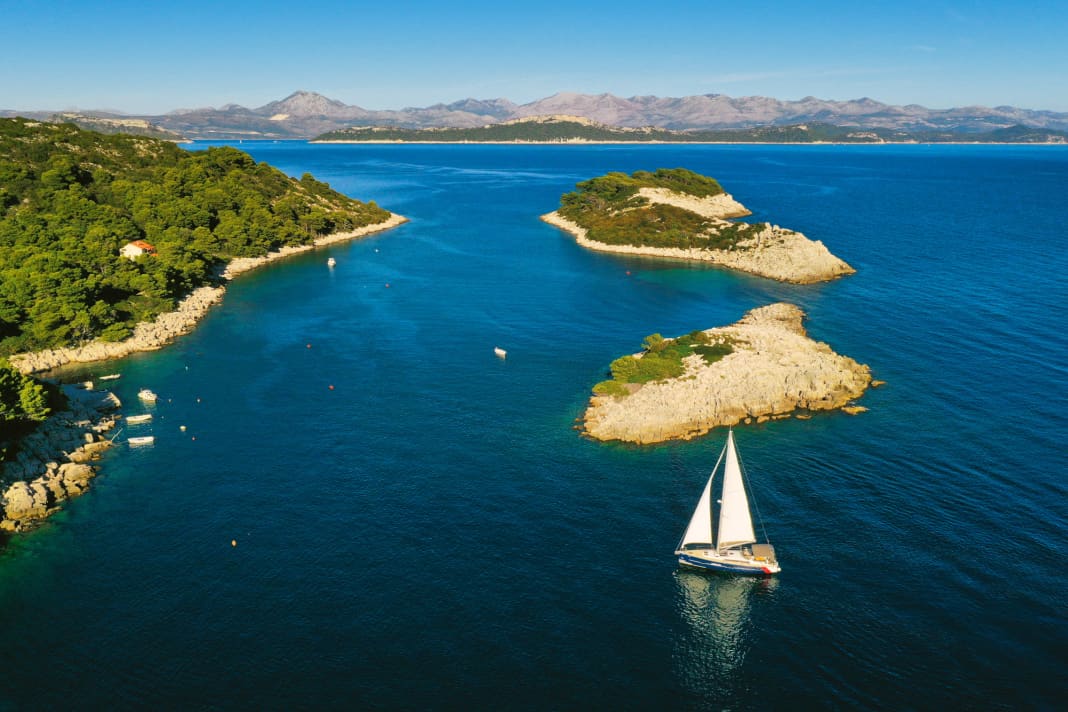





Objectives in this article:
The southern Adriatic is a favourite destination for many boat owners and charterers. But why are crews who have often sailed the coast between Istria and central Dalmatia drawn to the deep south of Croatia? The answer: the season is longer and warmer here and life is more relaxed. In fact, you can sail there all year round. However, between December and March, the air and water temperatures can drop below 15 degrees Celsius, and only a few konobas with jetties are still open.
From the beginning of April to the end of October, however, the air and water in southern Dalmatia are so warm that you can usually sit at the wheel in a T-shirt and jump into the water every day. It's up to you to decide whether you should travel to this tourist region in high season. It is at its busiest in August, when there are holidays not only in Germany and Austria, but also in Italy. In many places, this means arriving in good time to get the last free berth or konoba table. If you go sailing in the early and late season, you can easily get both. The staff are also more relaxed and many things are cheaper - from the flight ticket to the charter yacht to the lobster in the konoba.
The southern Adriatic still offers T-shirt weather in October
In 2022 and in the two previous coronavirus years, all available charter ships in southern Dalmatia were well booked until the end of October. Obviously, many crews are willing to accept the shorter days if they can save a lot of money in return and also enjoy travelling in a relaxed atmosphere.
We tried it out last year and sailed from Dubrovnik to Mljet in the last two weeks of October. The weather was actually still warm enough for us to sail in shorts and T-shirts every day. The oilskins we had packed as a precaution remained in the travelling bag. The bathing temperature in the southern Adriatic was around 20 degrees, just like in midsummer on the Baltic Sea. And the catering? The buoys for guests were still out everywhere, and most of the konobas with yacht moorings were also open. Only at two popular places on the island of Mljet were we literally too late.
The west of Mljet is a national park
Our cruise starts in the ACI Marina Dubrovnik and heads north-west via the Kolocepski Channel to the island of Sipan. From there we head for the north coast of Mljet and follow the coastline westwards to the island's national park. In the park, where the paths are as busy as ant trails in summer, we were alone and were able to cycle around Veliko Jezero on hire bikes. The ferries, which travel to the monastery island of Sveta Marija every quarter of an hour in the season with 80 people on board, were moored at the jetties.
If you want to go to the monastery, you have to drive yourself," said the captain of one of the ferries
"If you want to go to the monastery, you'll have to drive yourself," said the captain of one of the ferries and handed over the wheel of his boat to my skipper without further ado. As there were no other tourists on board, we did a few extra laps of the lake and were even allowed to moor the ferry. Experiences like this are probably out of the question in summer, when everything is packed.
Autumn sun and paradisiacal landscapes
After rounding Goli Rat, the western tip of Mljet, we sail back along the south coast to the bays of Saplunara and Podskolj. After a detour into the Stonski Channel, we head back to Dubrovnik through the Elaphite archipelago. Even in the low autumn sun, southern Dalmatia presents itself as a paradisiacal landscape. Although the cypress trees, which in many places reach up into the steel-blue sky, cast long shadows, olives, lemons, figs and pomegranates ripen in the gardens and burst into a glowing red colour in late summer.
At the end of the autumn trip, we have around 130 nautical miles on the log. The distances are manageable and there is time to see interesting things. There is plenty to discover in the region, from breathtaking scenery to stone witnesses to a great history and unique gastronomy.
Can we expect a lot of wind or even storms on a charter trip at the end of October? We had feared that. But I've never experienced weather as nice as that at the end of October in summer. The maestral blowing from the north-west woke up in the mornings for a fortnight, gave us 3 to 4 Beaufort during the day and died down again in the afternoon. There wasn't a strong wind for a single day.
Twelve stage stops in the Adriatic for post-sailing
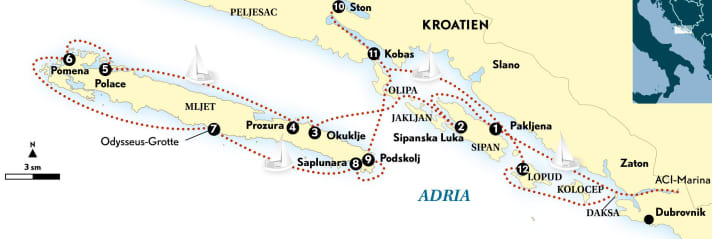
1. Pakljena (island of Sipan)
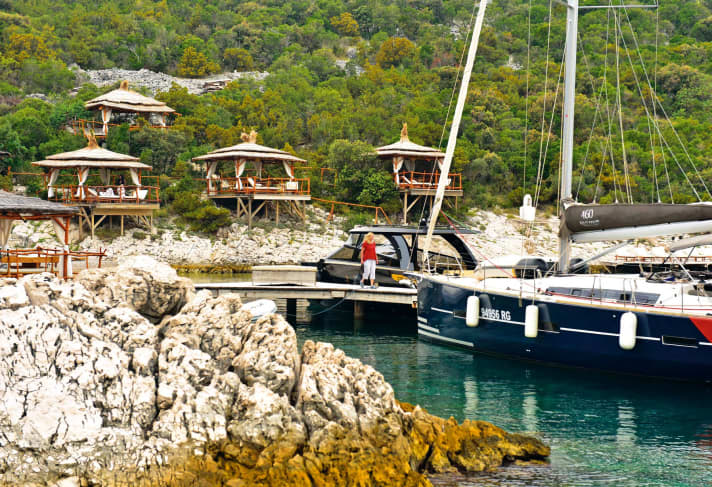
Pakljena is located in the north-east of Sipan and is known for its stylish "Bowa" restaurant with cabanas grouped around the bay. It was previously opened in June 2016 by young restaurateurs. However, they were involved in the worst accident in Croatian shipping on 24 April 2017 (YACHT reported). At night in poor visibility, the restaurant crew's rib collided with the SAR vessel of the Dubrovnik harbour authority on its way to the coast. Seven men and women died, two survived seriously injured. The "Bowa" was reopened by a new team. Four yachts can go alongside at the jetty. There are also six mooring buoys. During the season, moorings and cabanas must be booked online in advance. We moor up spontaneously in October. The chef spoils us with swordfish, tuna and octopus. In a cabana, you feel like you're in a private hut; each one has access to the sea, so you can even go for a leisurely swim between meals.
2. Sipanska Luka (Sipan Island)
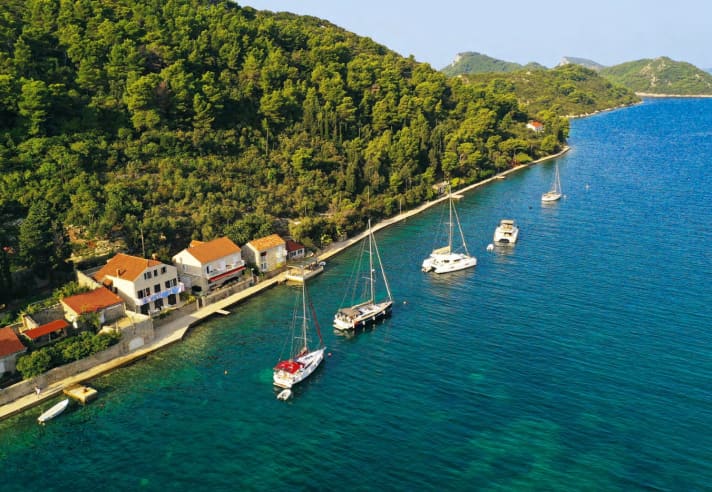
The deep bay is probably the safest natural harbour in the entire Elaphite archipelago. Only in strong north-westerly winds can the harbour become unsettled. The few mooring places on the north-east shore behind the breakwater are usually occupied. If you want to enjoy a good meal in the evening, you should moor up on a buoy in front of the "Kod Marka" restaurant. Top Croatian chef Marko Prizmic and his son Dino conjure up imaginatively prepared fish and seafood dishes.
3. okuklje (island of Mljet)
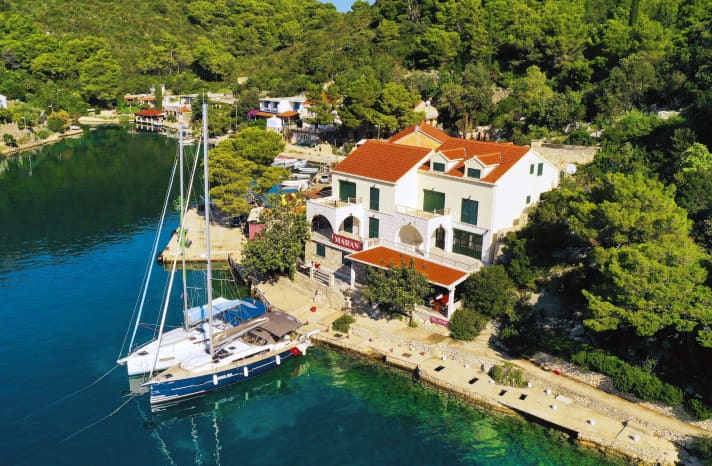
In the north-east of Mljet lies Okuklje Bay, which is very well sheltered in all weathers. There are now four konobas with mooring places on the shore. The most popular among sailors is Rajko Bozanja's "Maran". There is electricity, water and internet at the jetty. The restaurant is known for its fresh fish and seafood and excellent local wines. The house speciality is langoustine on spaghetti.
4th Prozura (island of Mljet)
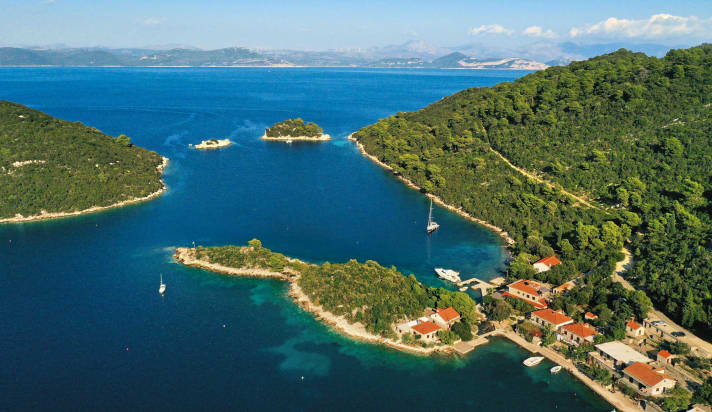
The well-protected Prozura anchorage is also located on the north-east coast of Mljet. The most popular anchorages are located in the lee of the small offshore islands that protect Prozura from the Mljetski Channel. The popular konoba "Marijina" in the south of the bay has its own pier with mooring places, although it is only 1.50 metres deep there. Sailing yachts moor at one of the seven mooring buoys. Prozura is one of the most beautiful bays on Mljet, but unfortunately the popular "Marijina" had already closed on 15 October. This year, however, the konoba plans to remain open until 30 October.
5th Polace (island of Mljet)
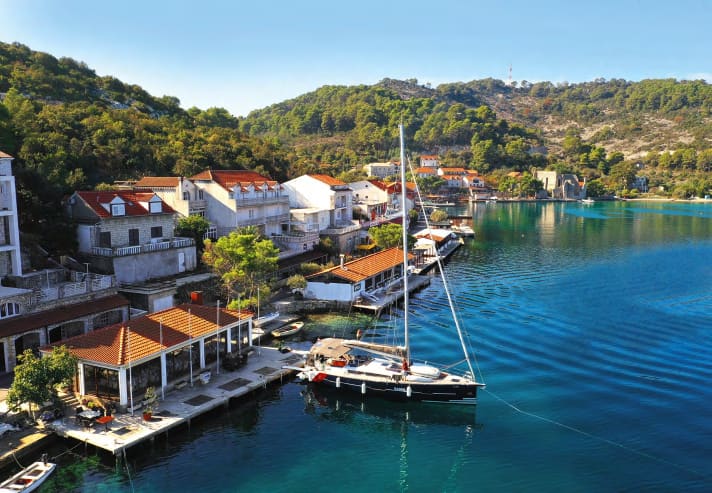
The sheltered bay in the north-west of Mljet has been a hotspot for nautical tourism for years. In the high season, up to 180 sailing and motor yachts are regularly moored here at buoys or at anchor. There is also a konoba avenue on the shore, which now has seven bars and restaurants in close proximity to each other. All of them offer their guests mooring places with electricity, water and internet. The mini market and bakery are open all year round. When we sail into the bay at the end of October, we can count the boats on one hand. We moor at the "Calypso". Innkeeper Stjepan Nodilo says that the many mega yachts that anchor in front of the bay in summer ruin the prices. "They come with their speedboats, travel from konoba to konoba and buy up all the lobster. This year they offered 200 euros each. I had to hide some so that I still had some for my guests."
6. Pomena (island of Mljet)
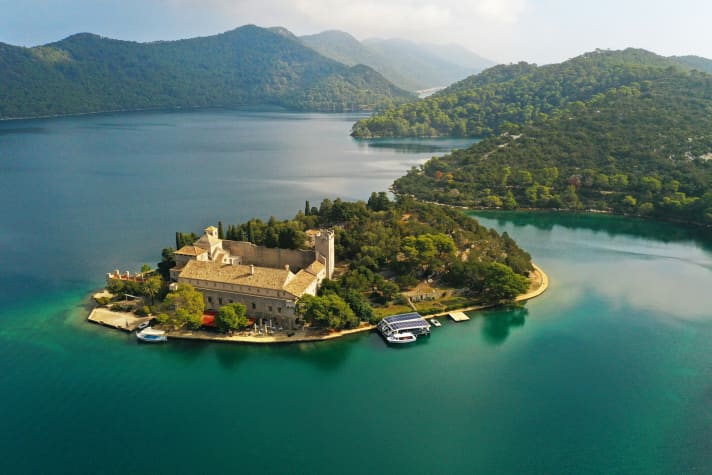
The harbour bay is located in the heart of the Mljet National Park and is the best starting point for excursions to Veliko Jezero (Great Lake) and the monastery island in it. There are also seven konobas in Pomena, all with moorings, electricity, water and internet. We moor at the new konoba "Herc" at the entrance to the village. The location is uniquely beautiful and we are served Dalmatian specialities on the pier. The entrance to the national park is 400 metres from the mooring. In October last year, each adult paid the equivalent of just over nine euros for entry plus just under four euros for the ferry to the Sveta Marija monastery.
We then cycle around Veliko Jezero on hire bikes. At the westernmost point, the village of Soline, fishing is still traditional, and in the rustic konobas by the lake you can get large portions from the grill for little money.
7th Odysseus Grotto (island of Mljet)
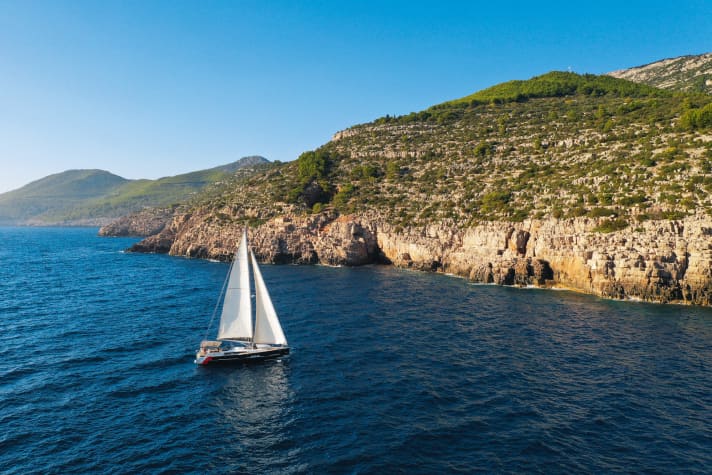
The Odysseus Cave, one of the most beautiful caves on the Croatian Adriatic, is located on the south coast of Mljet at 17°32.6' east longitude. It is difficult to spot from the sea, and there is a small stone house on the rock to the left of the cave. The cave has a large, open entrance on the land side and is a favourite spot for cliff divers. To the right and left of the sea-side entrance, irons have been concreted into the rocks. In calm weather and smooth seas, you can moor there with a small boat.
Anchoring is impossible as it is 40 metres deep in front of the cave. There is therefore no chance of approaching it in swell. When we head for the Odysseus Grotto at around 3.30 p.m., the Maestral is just starting to calm down. In October, it usually goes to sleep a good three hours earlier in the afternoon than in June. But that doesn't help, because the wind causes a swell of about one metre high to roll against the rock, which doesn't subside quickly. As a result, we can only see the cave from a distance.
The nymph Calypso is said to have held Odysseus captive in the cave for seven years after his shipwreck off Mljet
8th Saplunara (island of Mljet)

The popular Saplunara bay is located in the extreme south-east of Mljet. In the north-east, yachts can moor at the floating pontoon or a buoy at the "MS" restaurant. Mario Puhera and his girlfriend Ivana Ezgeta run the restaurant, which is popular with sailors. It is located on a hill above the sandy beach. The "MS" stands for fresh fish from the region and meat from the island. The ingredients come from regional, sustainable cultivation. For example, the salt is still traditionally collected by hand from the rocks at low tide. At the end of October, we are the only guests in the restaurant. In the high season, however, you only have a chance of a buoy and table if you book in advance (phone 099/474 61 81).
9th Podskolj (island of Mljet)
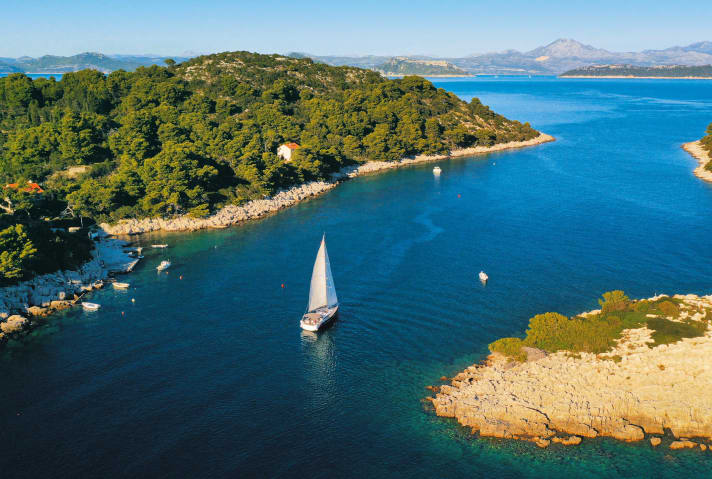
At the north-easternmost point of Mljet lies the Podskolj lagoon, which is protected by the two Skolj islands. You can anchor here at a depth of six metres or moor at one of the five buoys of the "Stermasi" restaurant. The lagoon is relatively safe, except in the event of a bora. The "Stermasi" sits prominently on a rocky outcrop with a view as far as Dubrovnik. As we sail into the lagoon, I ask the owner Adrian Stermasi which buoy we can use. Unfortunately, the popular fish restaurant is already closed at the end of October. Nevertheless, we enjoy sailing through the Podskolj lagoon.
10th Ston and Mali Ston
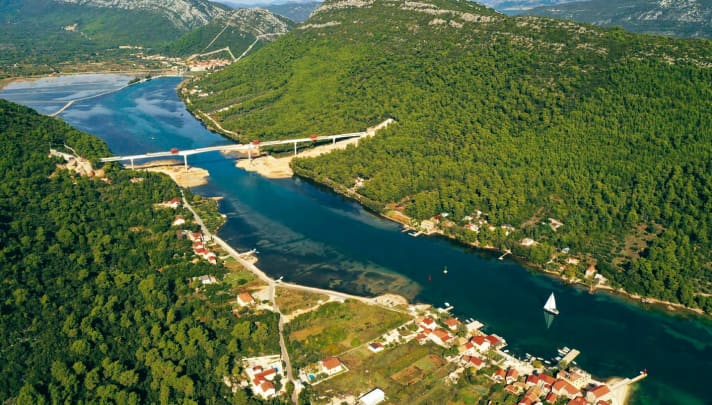
In the north of the Elaphite archipelago, you can steer into the Stonski Canal. In the new town harbour of Ston, you will be welcomed by harbour master Marin. Over a Caribbean drink in his bar, you quickly make friends with the friendly man. Marin is happy to explain the attractions of Ston to sailors and organises trips to the oyster farms. The salt pans are well worth a visit; at over 2,000 years old, they are among the oldest in the Mediterranean. The salt harvest begins in mid-August.
It is 1,300 metres from Ston to the district of Mali Ston. If you wanted to sail from Ston to Mali Ston, you would have to sail around the Peljesac peninsula and would have over 80 nautical miles ahead of you. Emperor Franz Joseph therefore wanted to have a canal built. In Mali Ston, the Austrian emperor's construction plans hang in the "Vila Koruna". The First World War put an end to Habsburg rule in the Adriatic and the plans for the canal.
If you're feeling sporty, you can hike over the fortress wall from Ston to Mali Ston, with 41 towers, seven bastions and three forts along the way. Built from 1333 to 1733 under the rule of the city-state of Ragusa (Dubrovnik), the wall was used to defend the salt pans. The white gold from Ston once founded Ragusa's wealth. The best oysters in the world are said to thrive in the mussel farms off Mali Ston, which even Giacomo Casanova and Emperor Franz Joseph raved about. In the "Vila Koruna", in the "Bota Sare" and in the "Kapetanova kuca" you can get them fresh on ice and lemon.
11. cobas
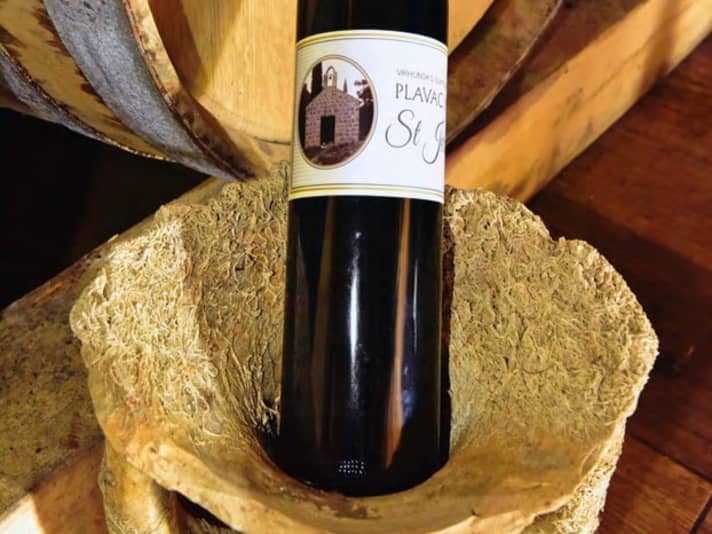
On the west coast of the Stonski Channel lies Kobas Bay, which is popular with sailors and is well sheltered from all winds. It can only get uncomfortable when the bora is blowing. There are three yacht moorings in the bay with moorings, electricity, water and internet: "Luka's Taverna", the "Fischerhaus Niko" and the "Gastro Mare". All three restaurants serve excellent food in a friendly atmosphere. The "Fischerhaus Niko" also produces oil from its own olives and makes wine.
12th Lopud (island of Lopud)
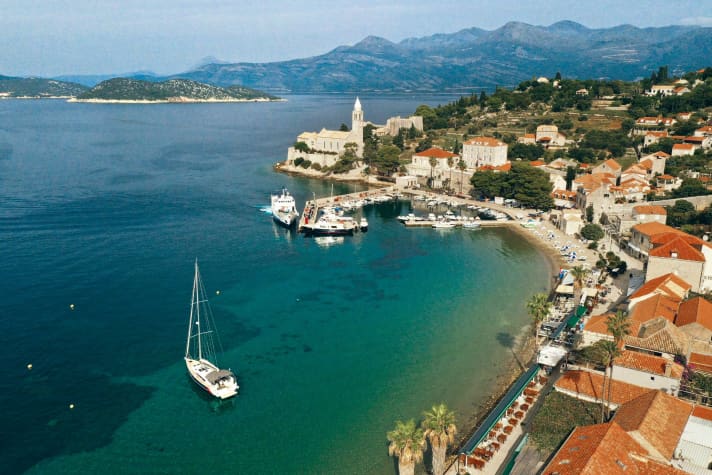
The town is the uncrowned capital of the Elaphite archipelago. Lopud has a mini harbour, which is still overcrowded even in October. The outer piers remain free for taxi boats and ferries from Dubrovnik. To the south are six mooring buoys of the "Obala" restaurant, which is one of the best on the island. Alternatively, you can anchor in front of the village. It is easy to moor your dinghy at the stub mole of the restaurant "La Villa". You will then be moored in front of the estate of the island's most prominent lady. La Villa" with its park-like garden belongs to Francesca von Habsburg. Her personal chef takes care of the flavours in the kitchen of the upmarket restaurant with its sea-view terrace. Lopud's most outstanding building is the former rector's palace. It was reconstructed in 2022 by the Dubrovnik Cultural Heritage Foundation and is due to be opened to the public this year.
Lopud was once the summer residence of the nobility. The monastery complex and the restored Gothic Renaissance palace are well worth a visit
Area tips for the cruise to Mljet and Sipan
Journey
Croatia Airlines and Lufthansa fly from 450 euros from all major German airports to Dubrovnik. Travelling by car from southern Germany or Austria can be a cheaper alternative. Thanks to the new Peljesac Bridge, it has been possible to avoid transit through Bosnia-Herzegovina since 2022.
Charter
We rented a Dufour 460 Grand Large built in 2019, with four cabins, each with its own bathroom, from the charter company "Under the Heavens" in the ACI Marina Dubrovnik. Depending on the season, the yacht costs 3,400 to 6,200 euros per week. The deposit is 2,000 euros. We took over the top-equipped boat in a very good optical and technical condition. UTH-SAILING.COM
Booking agency in Germany: Barbera Yachting in Würzburg: BARBERA-YACHTING.COM
Nautical information
The area does not pose any particular nautical challenges in stable weather conditions. However, you should be prepared for the possibility of bora (from the north-east), jugo (from the south-east) or thunderstorms (from the west). In this case, look for a bay or harbour that offers sufficient protection. Good weather forecasts for the area can be found at METEO.HR , WINDFINDER.COM , WINDGURU.CZ
Driving licence
German skippers require the Sportbootführerschein See (SBF) or higher licences. Austrians need at least the certificate of competence for the independent management of yachts in cruising area 2 (coastal cruising).
Radio certificate
One member of the crew must have a radio licence (VHF radio certificate/SRC/LRC or Croatian radio certificate).
Literature
"Küstenhandbuch Kroatien und Montenegro" by Bodo Müller and Jürgen Strassburger, 29.90 euros, and "Schlemmertörns in Kroatien" by B. Müller, S. Scheiter and J. Strassburger, 22.90 euros. Both published by Edition Maritim, order here
Free information for pleasure boating is sent out by the Croatian Tourist Board based in Frankfurt/Main, tel. 069/238 53 50, CROATIA.HR

